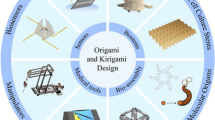Abstract
The molecular chaperone DnaK was optimized by directed evolution for better refolding activity toward two substrates and the identified DnaK variants were analyzed for characteristic changes in their mechanism. Remarkably, none of the variants was modified in or in close proximity to the substrate binding pocket, although their substrate affinity was increased. These results indicate that improvement in chaperone activity for specific substrates does not necessarily decrease substrate promiscuity.
Similar content being viewed by others
Literatur
Wang JD, Herman C, Tipton KA et al. (2002) Directed evolution of substrate-optimized GroEL/S chaperonins. Cell 111:1027–1039
Aponte RA, Zimmermann S, Reinstein J (2010) Directed evolution of the DnaK chaperone: mutations in the lid domain result in enhanced chaperone activity. J Mol Biol 399:154–167
Schweizer RS, Aponte RA, Zimmermann S et al. (2011) Fine tuning of a biological machine: DnaK gains improved chaperone activity by altered allosteric communication and substrate binding. Chembiochem 12:1559–1573
Bertelsen EB, Chang L, Gestwicki JE et al. (2009) Solution conformation of wild-type E. coli Hsp70 (DnaK) chaperone complexed with ADP and substrate. Proc Natl Acad Sci USA 106:8471–8476
Rudiger S, Germeroth L, Schneider-Mergener J et al. (1997) Substrate specificity of the DnaK chaperone determined by screening cellulose-bound peptide libraries. EMBO J 16:1501–1507
Han W, Christen P (2003) Interdomain communication in the molecular chaperone DnaK. Biochem J 369:627–634
Swain JF, Dinler G, Sivendran R et al. (2007) Hsp70 chaperone ligands control domain association via an allosteric mechanism mediated by the interdomain linker. Mol Cell 26:27–39
Author information
Authors and Affiliations
Corresponding author
Additional information
Regina Simone Schweizer 2001–2007 Studium der Chemie an der Universität Stuttgart mit Diplomarbeit im Fachbereich Biochemie bei Prof. D. H. Wolf, 2008–2011 Promotion am MPI für medizinische Forschung in Heidelberg in der Arbeitsgruppe von PD Dr. J. Reinstein, Abteilung Biomolekulare Mechanismen.
Jochen Reinstein 1981–1987 Biologiestudium an der Universität Heidelberg, 1987–1990 Promotion bei Prof. Dr. F. Wittinghofer. 1990–1992 Postdoc an der Brandeis University, Waltham, MA, USA, bei Prof. Dr. B. Jencks, 1993–2003 Gruppenleiter am Max-Planck-Institut für molekulare Physiologie, Dortmund. 2000 Habilitation für das Fach physiologische Chemie an der Universität Bochum. Seit 2003 Gruppenleiter am Max-Planck-Institut für medizinische Forschung Heidelberg und Privatdozent in der Fakultät für Biowissenschaften, Universität Heidelberg.
Rights and permissions
About this article
Cite this article
Schweizer, R.S., Reinstein, J. Protein-Origami für Fortgeschrittene: Wie DnaK besser falten lernte. Biospektrum 18, 372–375 (2012). https://doi.org/10.1007/s12268-012-0194-8
Published:
Issue Date:
DOI: https://doi.org/10.1007/s12268-012-0194-8




